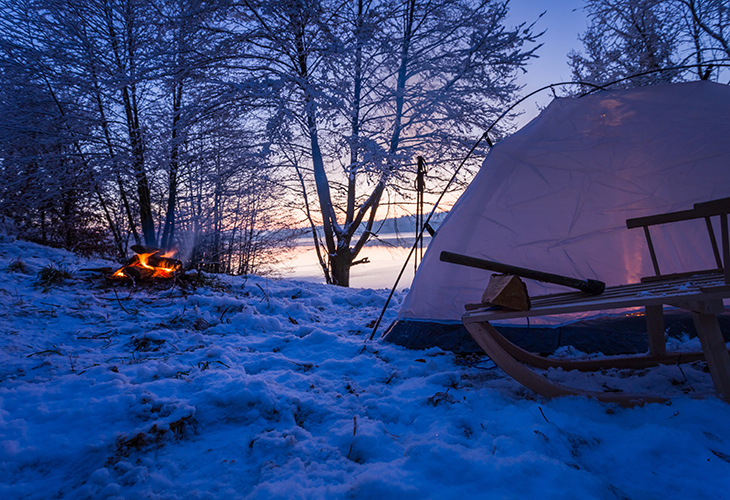Jos Mark
PublisherJos has been camping from a young age. Nowadays, he travels with his wife Ineke and their dog Noa in a Carthago C-Tourer 145 RB LE motorhome.

Most campers found at campsites this time of year stay in a caravan or camper. Only a handful of true die-hards venture out with a tent. It takes some toughness, but with the right precautions, winter camping in a tent can be perfectly doable.
Let’s be honest: most campers only visit campsites between May and September. Some extend their season from March to October, and only a handful dare to camp during the winter months. Among those winter campers, very few actually sleep in a tent. We understand why—but in reality, it’s a shame. With the right gear and proper precautions, winter camping in a tent can be an unforgettable experience.
In principle, you can go winter camping in any tent, but some will be more comfortable than others. Always choose a tent with an inner tent, as it provides insulation. Cotton tents breathe more than polyester or nylon tents, which means you’ll have less condensation inside. However, if a cotton tent gets wet and freezes, it becomes much heavier and stiffer than a polyester or nylon tent. You can reduce condensation by ensuring proper ventilation.
There are special four-season tents, but despite their name, they are not actually suitable for all seasons. In reality, they are only truly comfortable in winter, as they can be far too warm in spring and summer. However, if you plan to go winter camping more often, investing in one may be worthwhile. A four-season tent is sturdier, has more tent poles, and features at least two openings, ensuring you can always exit even in heavy snowfall.
If you’re going winter camping, you’ll need more than just a suitable tent—you also need to create a comfortable sleeping area. First and foremost, choosing a sleeping bag that’s appropriate for winter is essential. Opt for one with a comfort temperature of at least -10°C, preferably even lower. The lining of the sleeping bag also matters; materials like hollowfibre, supreme loft, or polarsoft provide good insulation. If you’re camping in truly wintry conditions, a mummy-style sleeping bag is the best choice. This design wraps closely around your body, keeping you warmer than a blanket-style sleeping bag.
A good sleeping bag alone isn’t enough—you also need proper insulation underneath you. Air mattresses don’t provide good insulation, as they allow cold air to rise from the ground. Instead, use a well-insulated sleeping mat. The insulation value of a sleeping mat is indicated by its R-value; the higher the R-value, the better it is for cold conditions. A mat with an R-value of 5 or higher is suitable for winter camping in a tent. For even better warmth, place an extra insulating mat underneath.
If you have the right gear, winter camping in a tent is a breeze—at least if you follow these tips. Worried about cold nights? Make sure you don’t crawl into your sleeping bag feeling cold, as warming up once inside is difficult. Take a nice walk before bed, warm up by the campfire, or preheat your bed with a hot water bottle.
It’s tempting to wear lots of layers at night, but don’t overdo it. Thermal underwear, long pants, a sweater, and socks are generally sufficient. A lot of heat escapes through your head, so wearing a hat is also a smart choice. Do your hands get cold easily? Gloves or hand warmers can help.
Your clothes for the next day will likely be freezing cold after a night in the tent. Prevent this by storing them at the bottom of your sleeping bag. And last but not least: take care of your body from the inside out. Your body burns a lot of energy to stay warm, so make sure your internal “heater” has enough fuel. If you’re cooking for yourself, use a propane gas stove, as butane gas doesn’t work in low temperatures.
Do you have experience with winter camping in a tent? Let us know!
Spotted an error? Email us. We appreciate it!